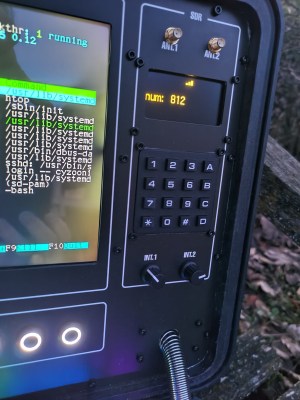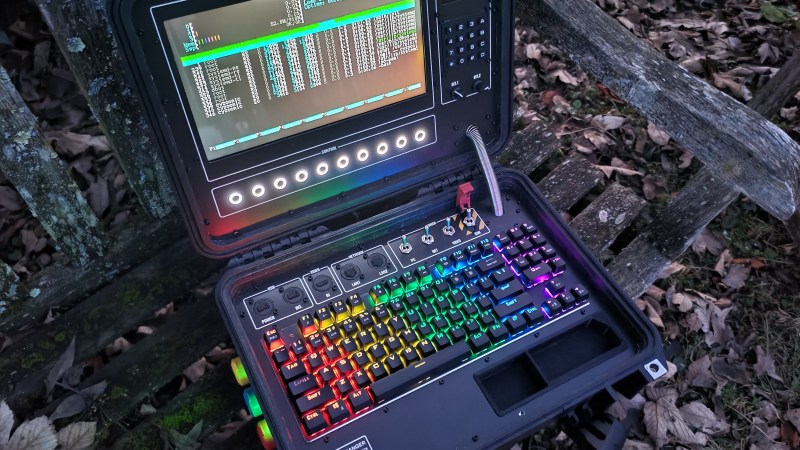Many people build cyberdecks just for the heck of it, and there’s nothing wrong with that at all. On the other hand, [cyzoonic]’s rugged ‘deck is a bit more purpose-built. In this instance, the purpose is software-defined radio.
 Underneath those sweet custom-cut panels lies a Raspberry Pi 3B and a BOM full of parts that can be had on Ali Express. There’s also an ESP32 that takes input from the keypad plus the 5 buttons that control the display, and the two potentiometers. [cyzoonic] can dial in frequencies with the knobs, or by punching in digits on the keypad.
Underneath those sweet custom-cut panels lies a Raspberry Pi 3B and a BOM full of parts that can be had on Ali Express. There’s also an ESP32 that takes input from the keypad plus the 5 buttons that control the display, and the two potentiometers. [cyzoonic] can dial in frequencies with the knobs, or by punching in digits on the keypad.
One of the problems with using a Pelican case is this — how do you install any type of panel without compromising the case’s water-tightness? [cyzoonic] mentions in the comments that Pelican makes a bracket that allows for panels and things to be screwed down without breaching the case. But in this case, [cyzoonic] made their own brackets in a similar fashion.
Another problem with Pelican cases (and cyberdecks in general that are built into hinged boxen) is something that doesn’t get enough attention: typing ergonomics. Personally, we take comfortable and ergonomic typing fairly seriously, and would love to see a cyberdeck that speaks to this issue.
In the meantime, we’ll have to take [cyzoonic]’s word that while it’s not terribly comfortable to type with the ‘deck on a tabletop, sitting on the floor hunched over the thing like a true hacker is much better. This is a work in progress (at least the IO project anyway), so we’ll be tuning back in occasionally to see if any more instructions appear.
Speaking of ergonomic cyberdecks, here’s the one that drew the line in the sand for us — [Tinfoil_Haberdashery]’s lovely ErgoDox-based NUC machine.
















I use something like that for automotive diagnostics, having got fed up killing laptops and their lack of upgradability I now have a micro ATX mobo and laptop screen in a pelican case. It’s robust, impossible to loose, and if I damage any part it’s cheap to fix
I’ve used the Panasonic ToughBook in the field for tuning car and boat electrical systems. (EFI and such) my latest purchase was General Dynamics field unit. Picked up for $50.00, and I installed windows 10. Yes, pretty much water proof.
My issue is I need dealer level diagnostics for all marques, and it doesnt always play nice in a VM, so having a small portable full pc where I can easily swap out boot drives(used to just use many many laptops) makes a lot of sence in my particular case. and obv the upgradability. Toughbooks are pricy here(UK) but found older thinkpads to be particularly robust.
I pull the CD/DVD out of the ToughBooks and slip in any one of many alternate boot drives. My buddy Erik uses his TB laptops for configuring Cummins and Detroit diesel boat engines. The i5 series will do whatever you need, and I’ve seen them for $50 to $150 depending on completeness.
I like that idea a lot. Swapping boot drives with ease is cool.
The older robust era of thinkpads co-insides with fairly cheap toughbooks spec and price wise second hand… If I had to type on one I’d always take the thinkpad though, but cheap enough Toughbooks do exist in the UK – I know I’ve got a fair few of them now…
The bit that will kill you with a Toughbook is the drive swap if you insist you must have it – the protective drive cages even second hand can end up costing more than the drive you’d put in them… And while you could dissemble the cages every time I suppose it isn’t a quick and simple task.
Witness the DVD >SSD swap..
Easy as pie.
Only when the Toughbook has a optical drive – and that isn’t all that common in the rugged lineups – none of mine ever came with the option of inbuilt ones.
Strange, I’ve never bought one without a DVD drive.. Perhaps it’s different where you are.
Beautiful build, almost something that could be sold as a commercial product.
The case is a bit pricy, but I have several power tool cases that might be repurposed.
I am torn on making a build based on a RBP, or a NUC, they both have merits, but then I see microATX on the menu…
Love this build!
Why not get the best middle ground of the options you list and take on a mini-ITX or mini-ITX-thin spec build (the mobos are almost identical except with the thin ones nothing on it may be more than 2.5cm tall (from memory) with a little more defined locations for CPU socket etc so getting cooling and case clearances right for any one of those mobos should fit any of them..
Its on my list of things to do soon – got a few things in CAD for that project, but hit the wall of I don’t have AC TIG, or Al welding Mig, or know anywhere I can borrow one which seems the best way to make some of the assemblies required for this case concept, so do I save for ages till I can get one or thicken up the parts so I can use small threaded fastenings. I suppose I could try brazing for the joints, but brazing AL is really damn hard…
Have you tried these https://www.toolking.com.au/aluminium-and-cast-alloy-repair-rods-ultra-bond-5pc-pack-brazing-soldering-welding/
I’ve used it for repairing aluminum radiators in quad bikes much easier than brazing as it doesn’t melt the aluminum. Makes a very strong bond.
Know such things exist but no never tried them, though that wasn’t the big reason I was calling Al hard to braze, certainly dealing with its oxide layer and getting adhesion is an issue, but the big one to me on this project at least is how readily it gives up heat, on larger bits with longer joins I’m not sure I can get it hot enough with the tools at hand.
Still its a good point, and the one I’m probably closer to being able to achieve/afford.
Some hard cases include dovetails on the inside around the sides.
I needed a portable HMI that would survive being tossed into the back of a truck, left on the ground in the field, etc. I opted to use a small hard case made by TuffCase, designed a SS face plate to be water-jetted and bent. The HMI panel secures to the face plate via standard brackets. Included a pocket on the side (with gland) for storing the flylead. Broke out the USB ports to the front plate as well for updating HMI software and for use of flash drives. The entire assembly is simply pushed into the dovetails of the hardcase and secure with friction. No modifications to the hard case needed. Only change I would make now would be to remove the manual vent screw and replace with a membrane pressure vent.
I’d like to see one with a removable keyboard. Give it some latches so it’ll stay in the box when you want it to, but so you can also easily pop it out and put it on the desk.